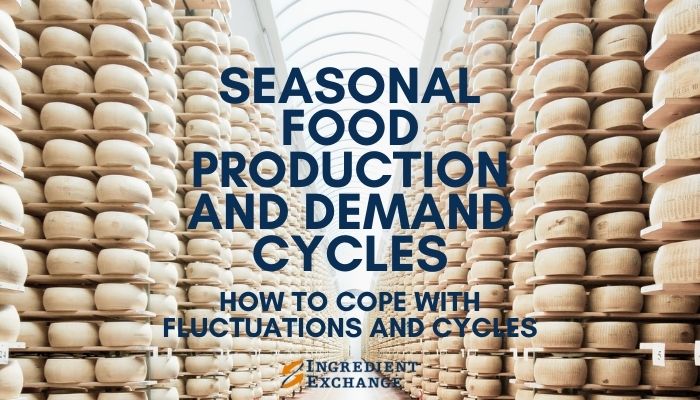Food production of all kinds experiences surges of supply and demand throughout a typical year. Supply fluctuates for a variety of reasons: seasons, animal reproductive cycles, shipping availability, producer profitability, etc. Likewise, demand fluctuates based on holiday seasons, school year vs. summertime, whether it’s food service or a grocery store, and many other macro-and micro-economic variables.
Every food industry has found a way to cope with these fluctuations and cycles.
The dairy industry is a prime example of this. This industry needs to convert a majority of the milk produced into products with a longer shelf-life (e.g. cheese, butter, NFDM, sweet whey powder). Milk production fluctuates throughout the year; in the Northern Hemisphere peaking in the spring and bottoming out in the late summer.
However, the demand cycle for dairy products peaks in the last quarter of the year (just after milk supply is at its lowest point for the year). To ensure a consistent supply of dairy ingredients throughout the year, the dairy industry utilizes third-party warehouses, annual sales contracts, and a vast network of dairy-focused trading companies to ensure product availability consistently throughout the year.
Monthly cheese production has reached the highest levels ever. As a result, manufacturers rely on trading companies more than ever. Dairy traders utilize financial resources, risk management tools, product knowledge, and confidence in their buyer networks to be able to hold cheese in inventory and resell it later for a positive margin.
Ingredient Marketplace, Food Exchange, and Surplus Food Buyers are types of networks that actively participate in this type of third-party network exchange.
Ingredient Exchange, as an example, consistently participates in this process by purchasing white and colored cheddar, nonfat dry milk, and butter directly from the manufacturers. We consistently have inventory of fresh, in-specification dairy ingredients. This is why it is important to consider the trading community as a sourcing arm: the role we play to help production facilities keep their warehouse space clear and cash available to continually pay the dairy farmers.
With the utilization of dairy commodity futures and risk-management tools, an effective trader is capable of selling inventory in almost any market condition (even in times of seasonally low prices). This puts traders in a position to have availability when manufacturers’ order pipelines get filled.
Dairy is just one example. The grain industry has vertically integrated, leading to a few players, who dominate the infrastructure and financing, to be able to buy and distribute the product evenly throughout the year.
The fruit industry utilizes freezing, purees, canning, and dehydrated food to ensure supply of ingredients from one growing season to the next.
Ingredient Exchange not only helps manufacturers with reselling problem and obsolete inventory but has the expertise and experience to be a sourcing arm for dairy ingredients. Our experiences allow us to manage price risk using the futures market while maintaining a customer base who will eventually buy products from us at a competitive price.



